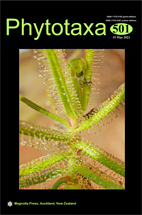Abstract
The Leguminosae family is one of the most representative in Brazil, with more than 2,800 native species in 222 genera. It is also one of the most representative families in all Brazilian phytogeographic domains, especially in the Atlantic Forest, where the Iguaçu National Park (ParNa Iguaçu) is located. The present study aimed to produce a synopsis of the Leguminosae species, and compare their distribution in three different areas of the park. ParNa has a total area of about 185,000 hectares, its vegetation is predominantly Semideciduous Forest (SF), in the areas of Foz do Iguaçu and Capanema, and a transition from this with Araucaria Forest (AF), in the area of Céu Azul. Fortnightly expeditions were carried out along the main trails of ParNa, from April 2018 to May 2019, there were also surveys in the platforms SpeciesLink, Jabot and the Reflora Virtual Herbarium, in addition to visits to the herbaria EVB, HCF, MBM, PUC-PR and UPCB. Sixty-three native species of Leguminosae distributed in 40 genera were found. The most representative genera were Senegalia with eight species, followed by Machaerium, Mimosa and Desmodium with four species each. Of these species, 24 are new records for ParNa, five were found only in the AF area, 51 only in SF and eight are found in both these vegetational types. Two species are endemic to Paraná, Mimosa prionopus and Senegalia rafinesqueana, and two are threatened, Apuleia leiocarpa and Gleditsia amorphoides. An identification key, scientific illustrations and/or photographs with diagnostic characters of the taxa and comments on the geographical distribution are presented.

